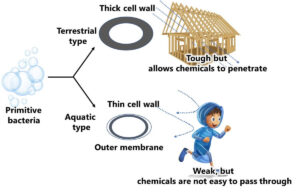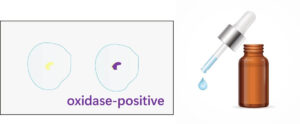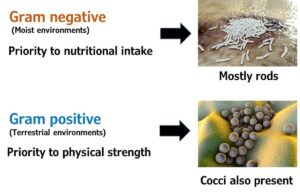Basic Course
The Extraordinary Relationship between Gram Staining and Microbial Properties
In this article, I'd like to introduce the remarkable connection between Gram staining and various properties of microorganisms that will be incredibly useful for beginners in this field. When studying microbiology, one of the first things we learn is Gram staining. You might think that this article will be a just another explanation of Gram staining(borering!), but you're in for a surprise. By reading this article, you'll gain a deep understanding of the relationship between Gram staining and essential microbial properties that you'll encounter in the field of food microbiology, such as resistance to chemical agents, secondary contamination in the environment, principles of selective media, the infectivity and toxin types of foodborne pathogens, and more, all connected!
Food Microbiology: Understanding the Human-Microbe Battle
In this article, aimed at beginners in the fields of food microbiology and microbiology, I will explain the relationship between foodborne pathogens, spoilage bacteria, and humans. From the perspective of utilizing stellar energy, both humans and microorganisms are considered losers compared to plants. This is because unlike plants, they cannot convert solar energy into chemical energy. From the viewpoint of extraterrestrials, plants may be the life forms worthy of respect, while humans and microorganisms might be seen as similar and inferior creatures. Therefore, food microbiology can be seen as a discipline that studies the battle between losers in terrestrial biology from an energy perspective.
Distinguishing Lactic Acid Bacteria from Gram-Positive Bacteria Using the Catalase Test
This article explores the use of the catalase test to distinguish lactic acid bacteria from other Gram-positive bacteria. It delves into the unique characteristics of lactic acid bacteria, including their catalase-negative trait and ability to survive in oxygenated environments.
Essential Guide to the Oxidase Test: Key Method for Identifying Gram-Negative Bacteria, Including Enterobacteriaceae
This article provides a comprehensive overview of the oxidase test, including its mechanism, principles, testing methods, and significance in detecting Gram-negative bacteria, particularly Enterobacteriaceae. We'll delve into how the test works, what it reveals, and precautions to take to avoid false positive results. Additionally, we'll explore the importance of the oxidase test in food hygiene and its relevance in testing for Enterobacteriaceae.
Understanding Gram-Negative Bacteria: The Role of the OF Test
In food microbiology, once you have isolated a Gram-negative bacteria, it's important to determine whether it is aerobic or facultative anaerobic. The Oxidation Fermentation (OF) Test is a straightforward way to make this determination. This article explains the principle behind the OF test and provides a brief overview of the testing process. The relevance of OF test results in food microbiology will also be discussed.
Unlocking the Secrets: How Oxygen Impacts Microbial Growth - A Guide for Food Microbiology Beginners!
When studying food microbiology, it's essential to understand the growth patterns of bacteria, especially if you identify them as Gram-negative bacilli. A significant differentiation is whether they are aerobic bacteria or facultative anaerobic bacteria. In this article, I will be breaking down this relationship between bacterial growth and oxygen. We'll explore the glycolytic pathway, the citric acid cycle (or TCA cycle), and the electron transport chain. Additionally, I'll explain what aerobic bacteria, facultative anaerobic bacteria, and strict anaerobic bacteria are.
Why are there no cocci among Gram-negative bacteria? Understanding the Meaning of Cocci and Rods in Microbiology.
In microbiology classes, one of the first things we learn is the distinction between cocci and rods. However, merely memorizing this fact can be dull and may cause you to miss out on the fascination of microbiology. In this article, we will explore together why some bacteria are cocci while others are rods. We will start by addressing the intriguing question of why Gram-negative bacteria found in food microbiology are predominantly rods, with no cocci.
Organising Gram-Negative and Gram-Positive Bacteria: A Guide for Food Microbiology
In recent years, species identification based on 16S rRNA gene analysis has become increasingly popular. As a result, bacterial classification has become more intricate and complex. However, in the field of food microbiology, it is essential to grasp the broader framework before delving into detailed classifications. In a series of upcoming articles, I would like to discuss the microbial classification method, which serves as a useful mental toolbox for organizing and memorizing various Gram-negative and Gram-positive bacteria commonly encountered in food microbiology. The composition of this mental toolbox differs slightly between Gram-positive and Gram-negative bacteria, making it advantageous to internalize these frameworks.
Visualising Microbial Counts: From Fresh Produce to Spoiled Food – A Walk Through the Microbial World
Imagine a vast field, stretching for kilometers, with just a few people scattered across it – each person representing a bacterium on the surface of fresh vegetables. This visualisation brings the invisible microbial world to life. But as food spoils, that serene scene quickly turns into the crush of a crowded train. In this article, we explore how microbial counts on fresh and spoiled food compare, helping us better understand the numbers that tell us when food is safe to eat.
E. coli O157: Why Only Humans Suffer Foodborne Illness While Cattle Remain Unharmed?
As a university professor specialising in food microbiology, I often address a compelling question: Why does E. coli O157 cause foodborne illness in humans while cattle remain unharmed? This curious phenomenon challenges our human-centric perspective on microbial relationships. In this article, we will delve into the complexities of this issue, exploring how E. coli O157 interacts with its hosts within the broader context of Earth's biological diversity. Join me as we uncover the interconnected narratives of microbes and their hosts, revealing insights that might shift our understanding of foodborne illnesses.









